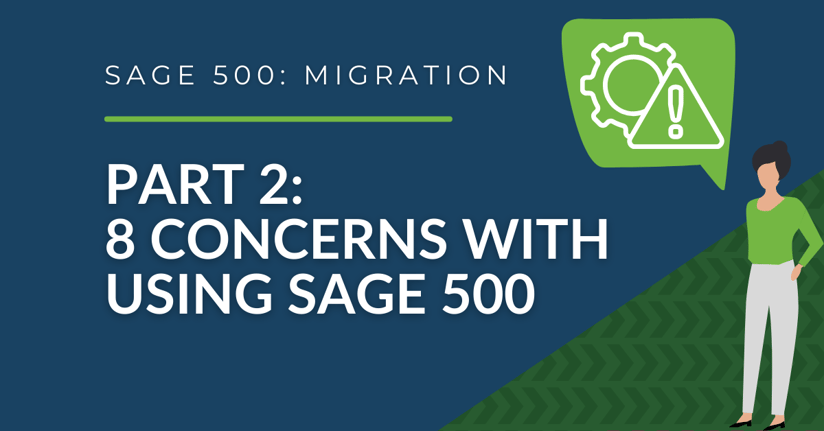Read the first and last part of this three-part blog series about what's next for you after Sage 500:
Part 1: Life After Sage 500—What's Next?
Part 3: Life After Sage 500—We're Here to Help You Prepare!
To be honest, our Sage 500 ERP team members at RKL eSolutions have hoped that Sage would resurrect the product. But we've had to face the reality that this isn’t going to happen. While no Sage 500 end-of-life date has been communicated, Sage has greatly reduced the resources of Sage 500, and the product releases reflect the small effort Sage dedicates to the product.
While RKL has continued to support the product for these past 12 years, we are seeing trends that make us believe we are reaching the tipping point where sticking with Sage 500 ERP is a significant risk for our clients.
8 Key Concerns You Should Have As You Continue to Use Sage 500:
1. Support resources Are Becoming Scarcer
Sage has significantly reduced their support team for Sage 500. Partners have followed suit by downsizing their teams or discontinuing support for the product over the past 12 years. As resources that can assist with the product are retiring, consultants are seeking opportunities with products that offer growth potential. The lack of future prospects in the Sage 500 space has led them to explore other options.
With no new resources being added and minimal investment in training team members, the availability of support for Sage 500 is diminishing, leaving you with limited resources.
2. Sage provides fewer enhancements with each version
Sage is not making any investments in Sage 500. Despite providing upgrades to maintain its compatibility within new operating systems and SQL Server versions, there is very little benefit from a functionality standpoint. As Sage continues to raise annual maintenance costs, the value added to the product remains disappointingly low.
3. Sage provides zero training on the product
Sage stopped pushing out training materials and hasn’t provided the ability to obtain training courses on the product in 10+ years.
4. Sage Partners are Dropping the Product
As partners see the number of Sage 500 clients they support dwindle into the single digits, more and more partners are choosing to step away from supporting the product entirely. With a shrinking client base, partners are finding it difficult to justify maintaining a team and providing training resources for a product that doesn't have a future.
5. data Security risks when updates aren't completed
Over the past several years, we have seen challenges as security updates are required in order to ensure the safety of systems and the data stored in them. The Sage 500 ERP Client still relies on Visual Basic 6, which was released in 1998 and has been unsupported by Microsoft since 2008. Vulnerabilities in unsupported technology can be exploited and could introduce a significant risk to the security of your data and network.
6. THIRD-PARTIES continue to drop support for their integrations and add-ons
While many add-ons have continued to be supported by third-parties, we are starting to see companies move away from Sage 500. This is another part of the natural progression. As the number of clients running 500 continues to decrease, so does the revenue that third-parties use to justify the ongoing support and update of their products.
7. No new third-party integrations
There haven't been any third-party-funded integrations for Sage 500 in many years. If you require a solution from a third-party provider that needs integration with Sage 500, you will be responsible for funding the entire development effort to make this integration possible.
8. very few support available for Obscure modules
While support for Sage 500 ERP will be limited, your ability to get support for the more obscure modules of Sage 500 will be even more challenging. Modules such as Project Accounting and Product Configurator already have limited resources that are familiar with them. Finding a resource that knows them well enough to support these modules will be challenging.
With diminishing support resources, minimal enhancements, lack of training opportunities, and potential security risks, it is clear that sticking with Sage 500 poses a risk to your business operations. As technology evolves and support for the product diminishes, it is essential to consider alternative options that offer growth potential and ongoing support. If you are currently using Sage 500 ERP, now is the time to evaluate your options and make informed decisions to ensure the long-term success of your business. For more information and guidance on transitioning away from Sage 500, feel free to reach out to us for further assistance.




